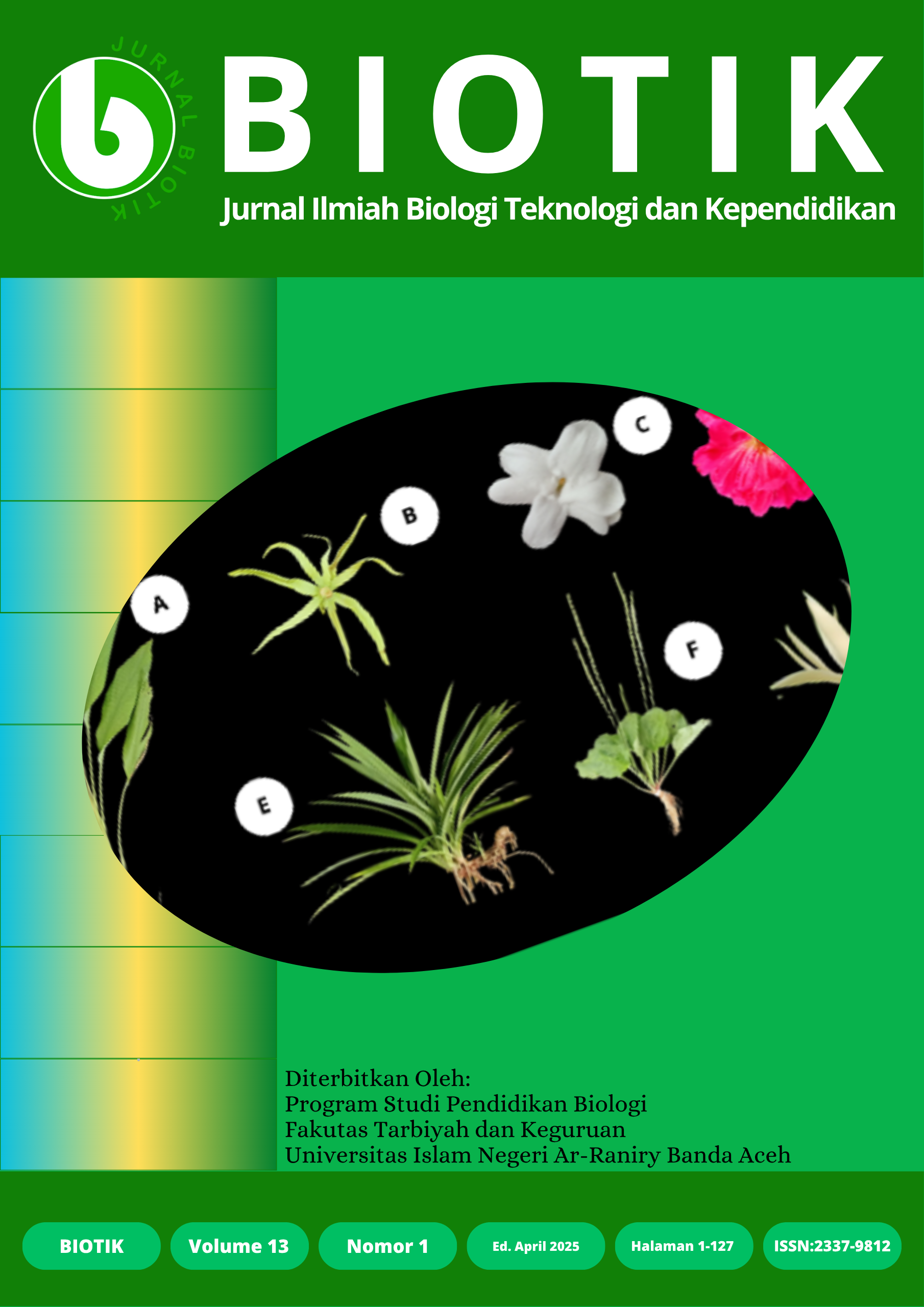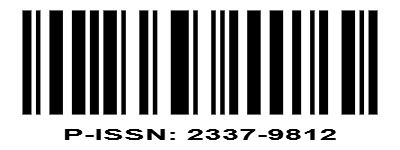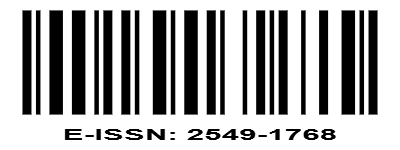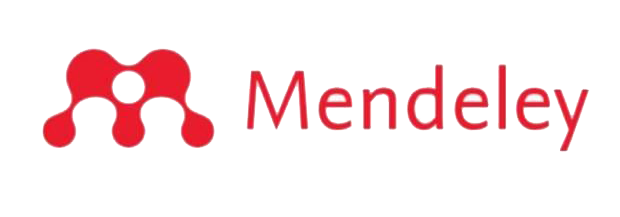The Role of the ASICC-SLICES Model in Promoting Science Literacy and Collaboration Skills: A Pathway to Educational Sustainable Development
DOI:
https://doi.org/10.22373/biotik.v13i1.25969Keywords:
Collaboration Skills, Education Sustainable Development, ASICC-SLICES model, Science LiteracyAbstract
The lack of science literacy and collaboration skills can hinder high school students in facing global challenges and supporting environmental sustainability actions. Therefore, developing science literacy and collaboration skills is crucial, particularly in biology education. The ASICC-SLICES model (Adapting, Searching, Interpreting, Creating, and Communicating based on Science Literacy Circles) enhances students' science literacy and collaboration skills. This quasi-experimental study, using a pretest-posttest control group design, aims to evaluate the effect of the ASICC-SLICES model on improving students' science literacy and collaboration skills and its contribution to Educational Sustainable Development. The study population consisted of tenth-grade students from a public high school in Lampung, with a sample of 70 students obtained using the Cluster Random Sampling technique. The research instruments included a science literacy test, questionnaires, observation sheets for collaboration skills, and documentation. Data were analyzed using MANOVA with an α of 0.05. The results showed that the implementation of the ASICC-SLICES model significantly improved students' science literacy and collaboration skills, with n-gain scores for the experimental and control groups (sig) 0.000<0.05 (α). These findings indicate that the ASICC-SLICES model contributes positively to students' awareness and actions in supporting environmental sustainabilityDownloads
References
Daryanto and S. Karim, Pembelajaran Abad 21. Yogyakarta: Gava Media, 2017.
OECD, PISA 2022 Assesment and Analytical Framework. Paris: OECD Publishing, 2023.
J. Voogt, O. Erstad, C. Dede, and P. Mishra, “Challenges to Learning and Schooling in the Digital Networked World of the 21st Century,” Journal of Computer Assisted Learning, vol. 29, no. 5, pp. 403–413, 2013, doi: 10.1111/jcal.12029.
C. Gormally, B. Peggy, and M. Lutz, “Developing a Test of Scientific Literacy Skills (TOLS): Measuring Undergraduates Evaluation of Scientific Information and Arguments,” CBE-Life Sciences Education, vol. 11, no. 4, pp. 364–377, 2012, doi: 10.1187/cbe.12-03-0026.
I. K. Suparya, I Wayan Suastra, and I. B. Putu Arnyana, “Rendahnya Literasi Sains: Faktor Penyebab Dan Alternatif Solusinya,” JIPCB, vol. 9, no. 1, pp. 153–166, Mar. 2022, doi: 10.38048/jipcb.v9i1.580.
B. Trilling and C. Fadel, 21 St Century Skills. United States: John Wiley & Sons, 2009.
P. Anantyarta and R. L. I. Sari, “Keterampilan Kolaboratif Dan Metakognitif Melalui Multimedia Berbasis Means Ends Analysis,” vol. 2, no. 22, p. 2, 2017, doi: https://doi.org/10.32528/bioma.v2i2.821.
A. M. Santoso, P. R. Primandiri, S. Zubaidah, and M. Amin, “Improving student collaboration and critical thinking skills through ASICC model learning,” J. Phys.: Conf. Ser., vol. 1806, no. 1, p. 012174, Mar. 2021, doi: 10.1088/1742-6596/1806/1/012174.
T. G. P. Ali, “Implementasi Metode Science Literacy Circles (Slc) Pada Pendekatan Saintifik Untuk Meningkatkan Literasi Sains Siswa Kelas VIII,” Jurnal Ilmiah Pro Guru, vol. 4, no. 2, 2018.
C. D’Agostino, “Collaboration as an Essential School Social Work Skill,” Children & Schools, vol. 35, no. 4, pp. 248–251, Oct. 2013, doi: 10.1093/cs/cdt021.
Tabachnick and Fidell, Using Multivariate Statistic. Boston: Pearson Education, Inc, 2007.
K. S. Lyle, “Teaching Science Problem Solving: An Overview of Experimental Work,” Journal of Chemical Education, vol. 78, no. 9, pp. 1162–1163, 2002, doi: http://dx.doi.org/10.1021/ed078p1162.
H. Lestari and I. Rahmawati, “Pendidikan Pembangunan Berkelanjutan Dimensi Pelestarian Lingkungan Melalui Model Pembelajaran RADEC pada Pembelajaraan IPA di Sekolah Dasar,” Jurnal Kajian Islam Modern, vol. 08, no. 01, pp. 1–13, 2022.
S. Fajar, “The Effect Of Using Small Group Discussion In Teaching Reading Comprehension,” in Prosiding Seminar Nasional Pendidikan Universitas Subang (SENDINUSA), in 1, vol. 3. 2021, pp. 292–296. [Online]. Available: https://ejournal.unsub.ac.id/index.php/sendinusa/article/view/1321
H. Hanifah and A. Retnoningsih, “Penerapan Metode Science Literacy Circles Untuk Meningkatkan Kemampuan Literasi Sains Dan Sikap Peduli Lingkungan Pada Materi Perubahan Lingkungan,” vol. 8, no. 2, pp. 68–78, 2019, doi: https://doi.org/10.15294/ijc.v8i2.22685.
F. W. Hesse, E. Care, and J. Buder, A Framework for Teachable Collaborative Problem Solving Skills. New York: Springer, 2015.
N. Hidayati, S. Zubaidah, and S. Amnah, “Effective Learning Model Bases Problem Based Learning and Digital Mind Maps to Improve student ’s Collaboration Skills,” International Journal of Evaluation and Research in Education (IJERE), vol. 12, no. 3, pp. 1307–1314, 2023, doi: 10.11591/ijere.v12i3.22654.
N. Anggraini and K. Nazip, “Application of Science Literacy Circles Method Based on Local Reality to Improve Student’s Science Literacy,” SEJ: Science Education Journal, vol. 6, no. 1, pp. 23–33, 2022, doi: 10.21070/sej.v%vi%i.1619.
N. B. Haka, M. Arifiana, M. C. Ningrum, Y. Astuti, and N. Hidayah, “Creative Thinking And Collaboration Skills: Improved Learning With The CORE Model Of Biology Subjects,” phen, vol. 12, no. 2, pp. 255–269, Mar. 2023, doi: 10.21580/phen.2022.12.2.12359.
Downloads
Published
Issue
Section
License
Authors who publish with BIOTIK: Jurnal Ilmiah Biologi Teknologi dan Kependidikan agree to the following terms:
- Authors retain copyright and grant the journal right of first publication with the work simultaneously licensed under a Creative Commons Attribution License that allows others to share the work with an acknowledgement of the work's authorship and initial publication in this journal.
- Authors are able to enter into separate, additional contractual arrangements for the non-exclusive distribution of the journal's published version of the work (e.g., post it to an institutional repository or publish it in a book), with an acknowledgement of its initial publication in this journal.
- Authors are permitted and encouraged to post their work online (e.g., in institutional repositories or on their website) prior to and during the submission process, as it can lead to productive exchanges, as well as earlier and greater citation of published work.












